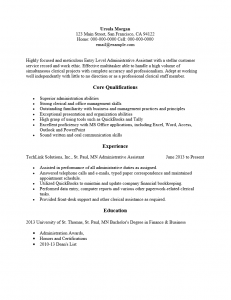Entry Level Administrative Assistant Resume Template |
|
The Entry Level Administrative Assistant Resume Template provides an excellent structure for entry level applicants in the administrative assistance field. This is a field where an applicant needs to have a high level of skill in communication, support, various software, and (at times) phone reception. These are just some of the abilities that a recruiter will be seeking in a viable candidate. While it may seem that an entry level applicant may have a difficult time competing with more experienced applicants, it is possible to increase one’s chances of attaining an interview with a professional looking resume (which the template provides) balanced with impressively worded sections (which you provide). Generally speaking, one should have a resume set up before they seek a position then revise if necessary when it comes time to apply for it. The Entry Level Administrative Assistant Resume will add a necessary level of organization to one’s searches and inquiries in seeking an interview with a potential employer.
How to Write
Step 1. The contact information on a resume is placed at the top of the page. This is a standard placement and should not be changed. There are some liberties one may take, for instance this information may be centered or aligned in accordance with a job hunter’s preferences. Also, if one wishes they may choose to make the font a bit larger or add an effect to the name such as bolding it. Regardless of the preference, it should contribute to the overall professionalism of a resume and should be as crisp looking as it would on a business card.
Step 2. It is also standard procedure to open a resume with a Profile or Objective Section. This section is meant to introduce the candidate’s resume. It should be a general summary of the candidate’s professional identity, intention, ability and/or skill set. This section should be about one to four sentences and generally does not need to have a title (these first two sections on a resume are the ONLY two sections not requiring a title). If writing an objective focus on your intention to obtain the position and how you would function in it. If writing a profile focus on your identity and skill set.
Step 3. The Core Qualifications section is where you will directly address the requirements listed in the employment opportunity you are pursuing. This will be a list of your abilities, skills, and employment history. The Core Qualifications section should support the Profile or Objective section. That is, it justifies the general statements previously made with specifics.
Step 4. The Experience section is where recruiters will gain knowledge of a candidate’s hard professional history. This section should be a list of your previous employers, where they were located, when you worked for them, what your job title was, and how you fulfilled the requirements of that title. The first line of each entry should be the previous employer’s name, city and state, job title held, and the date. The rest of the entry should be a bullet list of duties, responsibilities, and achievements you can call your own while there.
Step 5. It is often wise to close with a section regarding your academic credentials. This should simply be titled “Education” and should contain information about any degrees or certificates you earned. Include as much information regarding the institution and the type of degree earned as warranted. Also include any academic awards or notoriety you earned.


